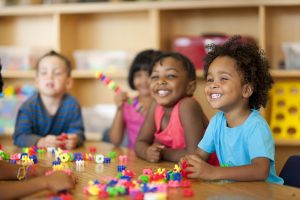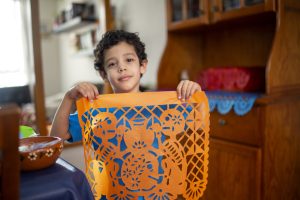- Families can get even more out of puzzle play by using words and hand gestures that support spatial thinking (we offer simple ideas!).
- Make your own jigsaw puzzles by cutting any paper into pieces and putting the pieces back together.
- Praising children’s effort and letting them do puzzles on their own helps build confidence.
Jigsaw puzzles are a fun and relaxing activity for families with young children to do together. But puzzle play offers even more than this. Puzzles are an opportunity for young children to explore key early math concepts, including shapes, sizes, and how and where one puzzle piece fits with another to make pictures or designs. This type of math involves spatial reasoning.
Research shows that children who play with puzzles are better able to imagine what something would look like if it were changed, such as rotated or flipped. [1] These spatial skills support children’s understanding of math and science and have been shown to predict children’s success in the STEM disciplines.
Children’s spatial thinking can grow by taking part in activities like puzzle play. Moreover, when parents use words that help build spatial thinking while working on puzzles together, this increases the benefits of puzzle play. [2] This is likely because spatial words such as straight, flat, curved, edge, inside, outside, long, and short help children think about spatial relationships.
Make Your Own Puzzles from Paper
One great thing about puzzle play is that you can make your own puzzles. No special materials are required to enjoy and learn from puzzles. Families can make their own puzzles using materials found around the house. A drawing, a cardboard box, a magazine, or a piece of scrap paper can all be cut in pieces and put back together as puzzles. Adjust the number of pieces depending on your child’s current puzzle skill and experience.
Let Children Take the Lead on Solving Puzzles
There are easy ways that parents and caregivers can help build their children’s spatial thinking. It can be difficult for adults not to put puzzle pieces in the correct spots when they see their children struggling to find and place them. But guiding children to find the right pieces through spatial words and hand gestures (“You need a piece with a flat edge, like this one,” or “You almost touched it!”) works well because it lets children practice their spatial thinking. When children actively engage in completing the puzzle, it builds their spatial skills and confidence.
Ideas for Math Conversations Around Puzzles
Parents can deepen children’s learning by finding and talking about spatial concepts that are naturally a part of puzzles. Here are some ideas:
- Point out features of puzzle pieces. “That piece is short and curved. We need a long triangle.”
- Describe the blank spaces where puzzle pieces go. “We’re looking for two edge pieces here, one for the right side of the puzzle and one for the top of the puzzle. Both will have straight sides.”
- Ask questions about different puzzle pieces. “How do you know that piece fits over there? Do you think this piece will fit—why or why not?”
- Give clues and prompts to help children find the right piece. “That piece is upside down. What happens if you flip it and turn it sideways?”
- Use hands, as well as words, to explain. “This is a corner piece.” (Point to the corner). “It has two flat edges. This puzzle has four corners. Let me show you.” (Point to each corner.)
Praise Children’s Effort and Practice
As families work together on puzzles, parents can praise the effort that their children put into solving the puzzle. Studies show that praising effort encourages children to practice and get better at activities such as puzzles (and indeed other challenges in life). This can help children to understand that people are not born knowing how to complete tasks like puzzles and they need to work at building their skills. For example, instead of saying, “You’re so good at puzzles,” try saying, “You worked hard on that puzzle,” or “Good job on that puzzle.”
These tips extend beyond jigsaw puzzles to blocks and other hands-on building activities. As families get used to thinking about spatial reasoning while playing, they will find even more opportunities to explore the spatial side of math together at home.
[1] Levine, S. C., Ratliff, K. R., Huttenlocher, J., & Cannon, J. (2011, October 31). Early Puzzle Play: A Predictor of Preschoolers’ Spatial Transformation Skill. Developmental Psychology. doi: 10.1037/a0025913
[2] Pruden, S. M., Levine, S. C., & Huttenlocher, J. (2011). Children’s spatial thinking: does talk about the spatial world matter? Developmental Science. 14. 1417-30. doi: 10.1111/j.1467-7687.2011.01088.x



